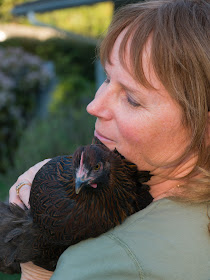Is it true that studies on chickens may provide the "golden egg" in understanding how flaxseed may decrease the severity of ovarian cancer in women?
According to
Science Daily (May 2010), University of Illinois researchers have discovered that a diet rich in flaxseed-- known for its omega-3 fatty acids-- actually "decreases the severity of ovarian cancer" in chickens. For hens, this is a very important matter because, by the age of four, nearly 50% of hens have ovarian cancer.
"The chicken is the only animal that spontaneously develops ovarian cancer on the surface of the ovaries like humans," said
Dr. Janice Bahr, one of the nation's leading poultry researchers and professor emerita of University of Illinois Department of Animal Sciences.
A study conducted by researchers Johnson and Giles,
Use of Genetic Strains of Chicken in Studies of Ovarian Cancer," (Department of Animal Science, Cornell University, 2006), cited that ovarian cancer is the fifth leading cause of death from all cancers in women. In fact, nearly 25,000 women are diagnosed with ovarian cancer each year or 1 in every 57 women. Most ovarian tumors are not diagnosed until Stage III or IV, where survival rates are only 5% to 40%. In citing Bahr's research,
Aces News--a University of Illinois publication, stated that hens fed a flaxseed-enriched diet for over one year experienced a significant reduction in late stage tumors.
What makes hens another basis for study is that they ovulate nearly daily for one or two years. Researcher
M. F. Fathalla hypothesized in 1971 that "frequent ovulation contributes to the risk for ovarian cancer." (A
study of Fathalla's hypothesis by the National Cancer Institute in 1997 neither supports nor refutes his hypothesis.) Some studies showing that multi-year birth control use and full-term births significantly reduce the risk of ovarian cancer seem to support Fathalla's theory.
Flaxseed is also known to decrease weight in women, which is a benefit as obesity is another risk factor for ovarian cancer; and, according to the
American Institute for Cancer Research, flaxseed is an excellent source of magnesium, manganese, fiber, thiamin, and selenium and also provides copper and protein.
Bahr suggested that the success of flaxseed in reducing the severity of ovarian cancer in chickens, "may provide the basis for a clinical trial that evaluates the efficacy of flaxseed as a chemosuppressant of ovarian cancer in women."
Let's hope that future studies prove that flaxseed, the "golden egg" that decreases the severity of chicken's ovarian cancer, has the same effects on women.
For more information: visit Dr. Dale Buck Hales blog, CancerChix, http://cancerchix.blogspot.com/.
New clip from WSIL-TV, Illinois Chickens-Possible-Key-To-Treating-Ovarian-Cancer





